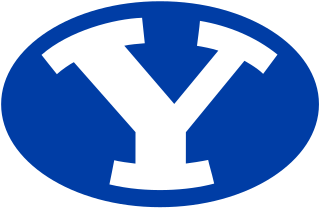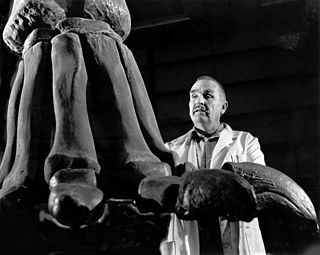
LaVell Edwards Stadium is an outdoor athletic stadium in Provo, Utah, on the campus of Brigham Young University (BYU). Primarily used for college football, it is the home field of the BYU Cougars, an independent in the Football Bowl Subdivision. Opened as "Cougar Stadium" in 1964, its seating capacity is 63,470.

Reuben LaVell Edwards was an American football head coach for Brigham Young University (BYU). With 257 career victories, he ranks as one of the most successful college football coaches of all time. Among his many notable accomplishments, Edwards guided BYU to a national championship in 1984 and coached Heisman Trophy winner Ty Detmer in 1990.

The Holy War is the name given to the BYU–Utah football rivalry. It is an American college football rivalry game played by the Brigham Young University (BYU) Cougars and University of Utah Utes. The game is part of the larger BYU–Utah rivalry. In this rivalry context, the term "Holy War" refers to the fact that BYU is owned and administered by The Church of Jesus Christ of Latter-day Saints and the University of Utah is a public university owned and administered by the state of Utah, with a traditionally large LDS student population. The proximity of the two schools, the athletic successes of the two teams, and the longevity of the series also contribute to the rivalry.

Palaeopteryx is a genus of theropod dinosaur now considered a nomen dubium. It was named and misidentified by J. A. Jensen in 1981, then redescribed by Jensen and K. Padian in 1989. At that time the binomial Palaeopteryx thomsoni was deemed invalid by Jensen. The only referred specimen is a single bone fragment.
The Stadium of Fire is an annual event held in the Brigham Young University's LaVell Edwards Stadium on or very near the United States' Independence Day. It is one of the main events for the America's Freedom Festival. This patriotic extravaganza with a cast of thousands features the largest stadium fireworks show in America. It is also televised worldwide to America's troops and their families on American Forces TV, as a gift from America's Freedom Festival.

The Dry Mesa Dinosaur Quarry is situated in southwestern Colorado, United States, near the town of Delta. Its geology forms a part of the Morrison Formation and has famously yielded a great diversity of animal remains from the Jurassic Period, among them Ceratosaurus, Supersaurus, and Torvosaurus. The quarry is found within the Uncompahgre National Forest.

James Alvin Jensen, was an American paleontologist. His extensive collecting program at Brigham Young University in the Utah-Colorado region which spanned 23 years was comparable in terms of the number of specimens collected to that of Barnum Brown during the early 20th century. He was given the name "Dinosaur Jim" during the media coverage of his activities. Perhaps his most significant contribution to paleontology was to replace the 19th-century web of external metal struts, straps and posts that had been used to mount dinosaurs with a system of supports which were placed inside of bones, which produced free-standing skeletons with few or no obvious supports.

The BYU Cougars football team is the college football program representing Brigham Young University (BYU), a private university owned by The Church of Jesus Christ of Latter-day Saints. The Cougars began collegiate football competition in 1922, and have won 23 conference championships and one national championship in 1984. The team has competed in several different athletic conferences during its history, but since July 1, 2011, they have competed as an Independent. The team plays home games at the 63,470-seat LaVell Edwards Stadium, named after head coach LaVell Edwards who won 19 conference championships, seven bowl games, and one national championship (1984) while coaching at BYU.

The BYU Cougars are the intercollegiate athletic teams that represent Brigham Young University (BYU), located in Provo, Utah. BYU fields 21 National Collegiate Athletic Association (NCAA) varsity athletic teams. They are a member of the West Coast Conference for most sports. Other sports compete in the Mountain Pacific Sports Federation and as independents. They were a member of the Mountain West Conference from 1999 to 2011 and before the formation of the MWC, the Cougars competed in the Rocky Mountain Athletic Conference, the Mountain States Conference, and the Western Athletic Conference.

The Brigham Young University Museum of Art, located in Provo, Utah, United States is the university's primary art museum and is one of the best attended university-campus art museums in the United States. The museum, which had been discussed for more than fifty years, opened in a 10,000-square-foot (930 m2) space in October 1993 with a large exhibit on the Etruscans. The museum is an integral part of the BYU College of Fine Arts and Communications and provides opportunities for students across the college and the university's campus.
The history of Brigham Young University (BYU) begins in 1875, when the school was called Brigham Young Academy (BYA). The school did not reach university status until 1903, in a decision made by the school's board of trustees at the request of BYU president Benjamin Cluff. It became accredited during the tenure of Franklin S. Harris, under whom it gained national recognition as a university. A period of expansion after World War II caused the student body to grow many times in size, making BYU the largest private university of the time. The school's history is closely connected with its sponsor, The Church of Jesus Christ of Latter-day Saints.
The main campus of Brigham Young University sits on approximately 560 acres (2.3 km2) nestled at the base of the Wasatch Mountains and includes 311 buildings. The buildings feature a wide variety of architectural styles, each building being built in the style of its time. The grounds and landscaping of the campus won first place in 2005 in America in Bloom's campus division. Furthermore, views of the Wasatch Mountains, can be seen from the campus. BYU's Harold B. Lee Library, which The Princeton Review ranked as the #1 "Great College Library" in 2004, has approximately 8½ million items in its collections, contains 98 miles (158 km) of shelving, and can seat 4,600 people. The Spencer W. Kimball Tower is home to several of the university's departments and programs and is the tallest building in Provo, Utah. Furthermore, BYU's Marriott Center, used as a basketball arena, can seat over 22,000 and is one of the largest on-campus arenas in the nation.
Fred Lewis Markham was an American architect in the early 20th century who designed movie theatres and many buildings on the campus of Brigham Young University (BYU) in Provo, Utah.
Gary Sheide is a former American football quarterback for Brigham Young University. He was the first quarterback to come out of LaVell Edwards's BYU "quarterback factory."
The 1972 BYU Cougars football team represented Brigham Young University (BYU) for the 1972 NCAA University Division football season. It was their first year under head coach LaVell Edwards and the Cougars finished over .500 for the first time since 1969.
The 1977 BYU Cougars football team represented Brigham Young University (BYU) for the 1977 NCAA Division I football season. The Cougars were led by sixth-year head coach LaVell Edwards and played their home games at Cougar Stadium in Provo, Utah. The team competed as a member of the Western Athletic Conference, winning a share of the conference title for the second consecutive year, sharing the title with Arizona State with a conference record of 6–1.
The 1976 BYU Cougars football team represented Brigham Young University during the 1976 NCAA Division I football season. The Cougars were led by fifth-year head coach LaVell Edwards and played their home games at Cougar Stadium in Provo, Utah. The team competed as a member of the Western Athletic Conference, winning a share of the conference title with Wyoming with a conference record of 6–1. BYU was invited to the 1976 Tangerine Bowl, where they lost to Oklahoma State.

Brigham Young University's David O. McKay School of Education specializes in teaching, administration, communication disorders, and educational inquiry. It is located in three buildings on Brigham Young University (BYU) campus in Provo, Utah, namely the David O. McKay Building, John Taylor Building, and the George Albert Smith Fieldhouse. It was ranked number 78 in the United States for best education schools for 2020.








